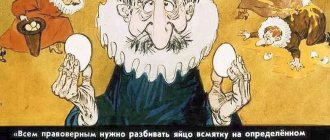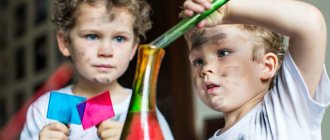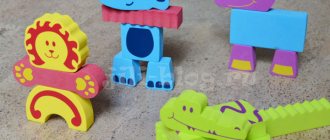Summary of a speech therapy lesson based on the fairy tale “The Ryaba Hen”
Junior group of compensatory type for children with severe speech impairment.
Goal: development of motor skills in children based on articulation and finger exercises, development of the rhythmic and intonation side of speech, formation of a long exhalation, development of visual-constructive activity, consolidation of sensory standards.
Equipment: a pockmarked chicken's cap (for the presenter), a table theater, large and small squares, large and small circles, woolen threads, a path made of black velvet paper, cards with the image of mouse tails: up and down, right and left, cubes with the syllable " PI", chicken feathers, graphic image of a feather, counting sticks, tape recorder.
Progress:
1. The speech therapist in Ryaba Hen’s hat invites children to go visit a fairy tale.
“And what kind of fairy tale this is, we’ll guess for ourselves. The heroes of this fairy tale hid behind the windows!”
The speech therapist points to the squares: large and small.
— What shapes do the windows look like? (into squares). Are they the same size? Where is the square? Where's the square? Who is hiding behind these square windows?
The child “opens” a large square. - Who's there? (Grandfather figurine from the tabletop theater) Children clap the word “grandfather” (one clap) grandfather is important (stretch lips)
The child opens a smaller square. - Who is there? (Baba) - two claps. Cheerful woman (smile) + singing the words BA-BA, BA-BA, BA-BA, GRANDFATHER to the melody of the song “I bake, bake, bake...” And Filippenko.
The speech therapist points to circles: large and small. -What are these figures called? Are they the same size? Where is the circle? Where's the circle? Who is hiding behind these circle windows?
The child “opens” a large circle. - Who's there? (Chicken - from the tabletop theater) Children clap the word “chicken” syllable by syllable.
One of the children opens a smaller circle. - Who is there? (Mouse) - two claps.
- So what fairy tale came to visit us? (“Chicken Ryaba”)
- What did the chicken lay? (testicle). Not simple, but which one? (gold).
The speech therapist shows the children a row of eggs, among which there is a “golden” one. - Find the golden egg. Tell me, what is it like? (yellow, shiny, beautiful)
- Well done, children, now stand in a big circle.
Remember who was hiding behind the big circle? (Chicken Ryaba) Now let’s make a small circle. Who was behind the small circle? (Mouse).
1. Motor exercise.
Hold hands. Let's go in a circle and sing:
“The chicken went out for a walk and will look for worms.
Row with your paws (children squat)
Look for worms” (children use the fingers of one hand to scratch the palm of the other hand). And in the other direction.
2. Finger exercises.
The speech therapist places woolen threads on the carpet. - Look how many worms there are. Let's collect them for the chicken. Connect your thumb and index finger like this. (Tweezer grip) Take the worm with your fingers and place it on the black track (velvet paper track)
The speech therapist draws the children's attention to the fact that one worm remains on the carpet. How many worms are there on the black carpet? (a lot of)
3. Articulation exercises.
Now sit down on the chairs.
- show how long the mouse’s muzzle is - children stretch their lips forward - 5 times.
- show how sharp the mouse’s teeth are - the children stretch their lips into a smile - 5 times.
The speech therapist shows cards with pictures of mice with four different tail positions (right, left, up, down). The speech therapist explains that when showing a card, you need to stick out your tongue in the same direction in which the mouse tail is pointing (each exercise is performed 5 times).
4. Rhythmic exercise.
The speech therapist demonstrates a cube with the syllable “PI”. + cubes for each child
-The “mouse song” is printed here - “PI”. Stand up, take the cube and place it on your right palm. We move the cube from palm to palm and sing this song. To the music of the song “I bake, bake, bake...”, children, together with a speech therapist, move the cube to each musical beat and at the same time sing the syllable “pi”.
5. Development of prolonged exhalation.
The speech therapist shows the children chicken feathers.
-Who lost these feathers? (Chicken Ryaba). Look how light and airy they are. The speech therapist shows the children how feathers easily fall onto the carpet.
Let's blow some feathers. Each child is given a feather on their palm.
We inhale through our nose and blow for a long, long time, not allowing the feather to immediately fall onto the carpet.
6. Development of visual-constructive activity.
The children sit at the tables.
The speech therapist shows a graphic image of a feather and examines it together with the children. Children run their fingers along the pattern. The speech therapist suggests laying it out from counting sticks (by applying it to a sample)
- Well done, children! Let's say goodbye to the Pockmarked Hen. The speech therapist takes off the chicken's cap. Let's say goodbye to her! And the Chicken will definitely come to us and play with us!
Bibliography.
1. V.A. Sharokhin “Correctional and developmental classes in the younger group” M. “Prometheus. Book lover" 2001
2. M.G. Borisenko, N.A. Lukin “Summaries of complex lessons on fairy tales with children 2-3 years old” St. Petersburg “Paritet” 2006.
3. O.B. Sizov “Six steps to speech development” St. Petersburg “KARO” 2003.
Lesson 1. Based on the plot of the Russian folk tale “Ryaba Hen”
Target:
1. Development of visual perception (shape, size).
2. Consolidation of verbal designation of quantities and counting skills.
3.Development of thinking, design skills based on a model.
4. Speech development (activation and enrichment of vocabulary, development of the ability to use phrasal speech when answering questions).
5.Development of attention and memory.
6.Improving communication skills. Cultivating a friendly attitude towards others.
Equipment: large soft toy; a poster depicting two square (large and small) and two round (large and small) windows; a poster depicting the heroes of the fairy tale “Ryaba Hen”; nesting dolls (according to the number of children); sets of three cubes (for the psychologist and each child); sets of three toys (for the psychologist and each child).
²In the psychologist’s office, children are “met” by Squirrel (a large soft toy). Children take turns greeting the toy: “Hello, Squirrel, forest beauty,” and give her compliments: “What a beautiful tail you have (beautiful fur coat, beautiful eyes, ears, etc.),” then sit down at the tables.
| Psychologist: | Children (suggested answers): |
| ²— Guys, a fairy tale is coming to visit us today, do you want to know what it is? - Try to guess for yourself. The heroes of this fairy tale hid behind the windows. | - Yes, we want to. |
| The psychologist shows a poster with images of geometric shapes - windows. | |
| -Who was hiding there? | |
| Points to the squares. | |
| -What are these figures called? — How many squares? -Are they the same size? - Who could hide behind these square windows? | - Squares. - There are two of them. - One is big, the other is smaller. |
| “Opens” a large square window | |
| - Who's there? | - Grandfather is there. |
| “Opens” a small square window. | |
| - Who is there? - What kind words can we say about grandfather and grandmother? - Let's see who could be hiding behind this big circle? | - Grandma is here. - Kind, caring, sweet, affectionate, love us... |
| “Opens” a large round window. | |
| - Who is this? -What’s behind the small circle? | - Chicken. |
| “Opens” a small round window. | |
| -So what fairy tale came to visit us? -Do you remember what the hen Ryaba said to her grandfather and grandmother? -What should we tell the hen Ryaba? - Well done, children, now get up and come to me. Let's form a big circle. Remember who was hiding behind the big circle? -And now a small circle. What was behind the small circle? | - Egg. —Chicken Ryaba. - “Don’t cry, grandfather, don’t cry, grandma, I will lay you not a golden egg, but a simple one.” -Thank you, chicken Ryaba, you are kind. - “Chicken Ryaba.” — The egg laid by the hen Ryaba. |
| Children form circles 3-4 times . The psychologist praises the children and distributes nesting dolls to the kids. | |
| - Now let’s sit down at the tables. | |
| The children sit down. | |
| ²—Each of you has a matryoshka doll on the table. Take it apart. | |
| Children disassemble the nesting doll. | |
| -What are you doing? - Now assemble the nesting doll. | — Let’s disassemble the nesting doll. |
| Children collect a toy. | |
| - What are you doing? | - We are collecting matryoshka dolls. |
| ² A psychologist makes a construction of three cubes | |
| - What do you guys think I’m building? —How many cubes do you need to take to build such a house? — Take the cubes and build a house. | - Turret..., house..., gate..., garage... - Three cubes. |
| Children take three cubes from the psychologist’s table and build according to the model. | |
| - Well done guys, they turned out to be good houses! Can we put a matryoshka doll in the house? -And why? - Right. Who can live in such a small house? | - No. —The nesting doll is big, but the house is small. -Mouse..., frog..., gnome... |
| ²The psychologist collects nesting dolls and gives the children identical sets of Kinder Surprise toys (for example, a gnome, a car, an airplane), then displays a row of three toys on his table. | |
| —What toys are on my table? — How many toys are on the table? | -Car, plane, gnome. - Three toys. |
| The psychologist asks the children to remember and reproduce the sequence of the proposed series. Children complete the task. | |
| ² - Well done, children (encouragement is necessary even if the children do not cope with the task), and now we will remember and tell Squirrel what we did in class. |
Children remember the course of the lesson, talk about the work done, say goodbye to the psychologist, and say goodbye to the soft toy.



